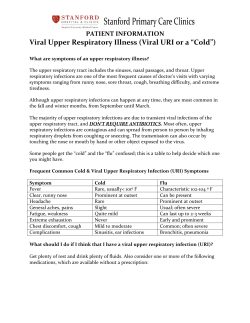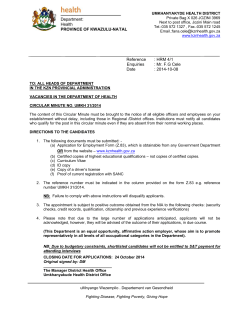
Essentials of Pathophysiology CHAPTER 22 RESPIRATORY TRACT INFECTIONS, NEOPLASIA, AND
Essentials of Pathophysiology CHAPTER 22 RESPIRATORY TRACT INFECTIONS, NEOPLASIA, AND CHILDHOOD DISORDERS PRE LECTURE QUIZ True/False F T F T T Bacteria are the most frequent cause of respiratory tract infections. Influenza is a viral infection that can affect the upper and lower respiratory tracts and is transmitted by aerosol or direct contact. Primary tuberculosis represents either reinfection from inhaled droplet nuclei or reactivation of a previously healed primary lesion. Typical pneumonias result from infection by bacteria. Acute bronchiolitis is a viral infection that has a peak incidence at 3 to 6 months of age and is most commonly caused by the respiratory syncytial virus (RSV). PRE LECTURE QUIZ epiglottitis Mycobacterium Lung rapid upper The common cold is a viral infection of the __________ respiratory tract. One distinguishing feature of influenza is __________ onset. Tuberculosis is an infectious disease caused by __________ tuberculosis, a rod-shaped aerobic bacterium that is resistant to destruction and can persist in necrotic and calcified lesions for prolonged periods and remain capable of reinstating growth. __________ cancer is the leading cause of cancer deaths among men and women in the United States. Acute __________ is a dramatic, potentially fatal condition characterized by inflammatory edema of the supraglottic area, including the epiglottis and pharyngeal structures, that comes on suddenly and carries the risk of complete obstruction. UPPER RESPIRATORY VIRUSES IN ADULTS Common cold Rhinosinusitis Influenza Catarrh- Excessive mucus secretion THE COMMON COLD Rhinoviruses Parainfluenza viruses Occur in children younger than 3 Respiratory syncytial virus Occur in early fall and late spring in persons between ages 5 and 40 Occurs in winter and spring in children younger than 3 Coronaviruses and adenoviruses Occur in winter and spring : any of a family (Adenoviridae) ofDNA viruses shaped like a 20sided polyhedron, causing respiratory diseases (as catarrh), and including some capable of inducing malignant tumors :any of various singlestranded, RNA-containing viruses that cause respiratory infection in humans and resemble a crown when viewed under an electron microscope because of their petalshaped projections. RHINOSINUSITIS (SINUSITIS) Infection or allergy obstructs sinus drainage Acute: facial pain, headache, purulent nasal discharge, decreased sense of smell, fever Chronic: nasal obstruction, fullness in the ears, postnasal drip, hoarseness, chronic cough, loss of taste and smell, unpleasant breath, headache INFLUENZA In the United States, approximately 36,000 persons die each year of influenza-related illness Transmission is by aerosol (three or more particles) or direct contact Upper respiratory infection (rhinotracheitis) Viral pneumonia Like a common cold with profound malaise Fever, tachypnea, tachycardia, cyanosis, hypotension Respiratory viral infection followed by a bacterial infection Viral Particles QUESTION For which viruses is a 2-year-old most at risk? a. Rhinoviruses b. Parainfluenza viruses c. Respiratory syncytial virus (RSV) d. All of the above e. b and c ANSWER d. b and c Rationale: Slightly older children (> 5 y) are at risk for rhinoviral infections. Children under the age of 3 are at risk of infection from both parainfluenza viruses and RSV. MECHANISM OF VIRAL INFECTION AND TREATMENT amantadine, rimantadine zanamivir, oseltamivir PNEUMONIA—INFLAMMATION OF ALVEOLI AND BRONCHIOLES Typical: bacteria in the alveoli Lobar: affect an entire lobe of the lung Bronchopneumonia: patchy distribution over more than one lobe Atypical Viral and mycoplasma infections of alveolar septum or interstitium Pneumonia Typical Pneumonia inhaled and cultured particles in the alveoli Atypical when virons invade and colonize in the alveolar septum Type of pneumonia is further identified by lung or bronchial location. ONSET OF PNEUMONIA Infection Signs of systemic inflammation Malaise Chills and fever Inflammation Serous exudate Congestion, productive cough serous exudate Blood-tinged sputum Pleuritic pain fibrous exudate: RED HEPATINIZATION WBCs denature hemoglobin: GRAY HEPATINIZATION consolidation Hepatinization – Tissue that takes on the appearance of Liver IF WBCS OVERCOME THE INFECTION WBCs denature hemoglobin: GRAY HEPATINIZATION WBCs destroy fibrous proteins and liquefy exudate: it is reabsorbed into the circulation resolution QUESTION Tell whether the following statement is true or false. In the progression of pneumonia, serous exudate develops before fibrous exudate. ANSWER True Rationale: Serous exudate develops (just after inflammation) before fibrous exudate, and is characterized by a congested, productive cough. If the pneumonia does not resolve at this stage, fibrous exudate develops, and the patient will experience pleuritic pain (worse when taking a deep breath or coughing) and may expectorate blood-tinged sputum. TUBERCULOSIS World’s foremost cause of death from a single infectious agent Causes 26% of avoidable deaths in developing countries Drug-resistant forms Mycobacterium tuberculosis hominis Aerobic Protective Can waxy capsule stay alive in “suspended animation” for years INITIAL TB INFECTION Macrophages begin a cell-mediated immune response Takes 3–6 weeks to develop positive TB test Results in a granulomatous lesion or Ghon focus containing Macrophages T cells Inactive TB bacteria GHON COMPLEX Nodules in lung tissue and lymph nodes Caseous necrosis inside nodules Calcium may deposit in the fatty area of necrosis Visible on x-rays CASEOUS NECROSIS GHON FOCUS CAVITARY TUBERCULOSIS CAVITARY TUBERCULOSIS & BRONCIIAL PNEUMONIA DISCUSSION If someone in your class has a positive TB test. Question: What does this mean? Are you at risk of infection? PRIMARY TB usually isolated in Ghon foci bacteria are inactive not contagious primary TB if immune response is inadequate, bacteria multiply in the lungs progressive primary TB MILIARY TB Miliary TB lesions look like grains of millet in the tissues Meat inspection was introduced to keep them out of the food supply Pasteurization of milk was introduced to keep TB out of the milk supply progressive primary TB signs of pneumonia bacteria in sputum and exhaled droplets bacteria may erode blood vessels and spread through the body MILIARY TB SECONDARY TB Reinfection from inhaled droplet nuclei Reactivation of a previously healed primary lesion Immediate cell-mediated response walls off infection in airways Bacteria damage tissues in the airways, creating cavities Signs of chronic pneumonia: gradual destruction of lung tissue “Consumption”: eventually fatal if untreated QUESTION Which type of TB may be reactivated if the patient becomes immunocompromised? a. Primary b. Latent c. Miliary d. Secondary ANSWER Secondary Rationale: Secondary TB, often referred to as reactivation or reinfection TB, may occur if patients are reexposed to TB bacilli (after a primary infection) or if they become immunocompromised (they are unable to contain the infection). d. CAVITARY TUBERCULOSIS LUNG CANCER Bronchogenic carcinoma Arises from epithelial cells lining the lungs Small-cell lung cancer Non–small-cell lung cancer º Large-cell carcinoma º Squamous cell º Adenocarcinoma ADENOCARCINOMA OF THE LUNG Large Cell Carcinoma MANIFESTATIONS OF LUNG CANCER Changes in organ function (organ damage, inflammation, and failure) Local effects of tumors (e.g., compression of nerves or veins, gastrointestinal obstruction) Ectopic hormones secreted by tumor cells (paraneoplastic disorders) Nonspecific signs of tissue breakdown (e.g., protein wasting, bone breakdown) RESPIRATORY DISTRESS SYNDROME Lack of surfactant; infants are not strong enough to inflate their alveoli Protein-rich fluid leaks into the alveoli and further blocks oxygen uptake Treatment with mechanical ventilation may cause bronchopulmonary dysplasia and chronic respiratory insufficiency RESPIRATORY DISTRESS SYNDROME Lack of surfactant; infants are not strong enough to inflate their alveoli QUESTION Tell whether the following statement is true or false. Premature infants are at greater risk of developing respiratory distress syndrome (RDS) than term infants. ANSWER True Rationale: RDS occurs due to a lack of surfactant in the alveoli (the surfactant is produced by alveolar cells, and keeps them inflated). Surfactant is typically produced from week 28 (gestational age) through term (40–42 weeks). The more premature the infant/neonate, the greater the likelihood that there will be insufficient surfactant to sustain ventilation. RESPIRATORY OBSTRUCTION IN CHILDREN Increased airway resistance Extrathoracic º º Prolonged inspiration; inspirational stridor Inspiratory retractions as ribs are moved outward and body wall does not expand with rib cage Intrathoracic º º airways (upper airways) airways (lower airways) Prolonged expiration with wheezing Rib cage retractions as ribs are pulled inward, but air does not leave lungs OBSTRUCTIVE DISORDERS Upper airway Croup Epiglottitis Lower airway Acute bronchiolitis QUESTION Tell whether the following statement is true or false. Epiglottitis causes stridor. ANSWER True Rationale: Epiglottitis affects the upper airway (inflammation causes the lumen of the upper airway to become more narrow). When the child inspires, it is difficult to pass air through the narrowed airway. This causes noisy inspiration/stridor.
© Copyright 2025












